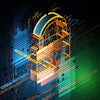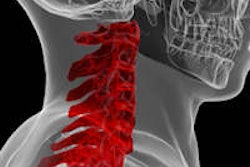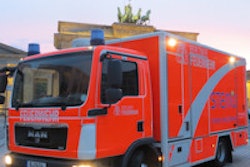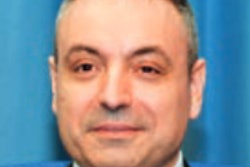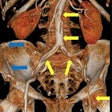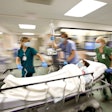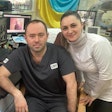
Over the past decade or so, the increasing demand for emergency CT of the head, cervical spine, and body has led to a tenfold or more increase in the demand for radiologists being called out at night. At the same time, a similar revolution has occurred with the access to, and display of, images.
Before PACS, when radiologists were called in the middle of the night, they would drive into the hospital to review the images on film and write a report on paper notes. Technological advances make it possible to access images at home on their laptops. Whilst this was a comfort initially, very soon the huge demands for nighttime CT resulted in radiologists getting very little sleep at night.
 Dr. Neelam Dugar is a consultant radiologist at Doncaster Royal Infirmary, U.K., and chair of the Royal College of Radiologists' Imaging Informatics Group.
Dr. Neelam Dugar is a consultant radiologist at Doncaster Royal Infirmary, U.K., and chair of the Royal College of Radiologists' Imaging Informatics Group.The traditional on-call system, which required radiologists to work a full day on the next day, was not working any longer, particularly when the European Working Time Directive was introduced to protect junior doctors or trainees. Teaching hospitals in the U.K. moved from an on-call system to shift-working for trainees, who were first on call for radiologists. This shift system worked in teaching hospitals with trainees available at night, but district general hospitals (with one, two, or no trainees) were unable to cope with the increasing demand for CT at night. They did not have adequate radiologists to support shift-working at night.
Commercial companies such as NightHawk, Medica, and Telemedicine Clinic saw an opportunity to provide nighttime teleradiology services. They have been successful in providing the support needed to meet the demands for nighttime CT reporting. Despite the increased cost of a private partner providing CT reporting services, they give much-needed support to hospitals struggling to recruit radiologists to cope with the demands of modern-day radiology.
On the whole, the practice of individual hospitals contracting out nighttime services is expensive for a public funded health system, such as the U.K.'s National Health Service (NHS). There are also anecdotal concerns expressed about the standard and quality of reports from some private company radiologists. Many of us are of a view that there needs to be a U.K.-wide national review of nighttime CT reporting services in the NHS.
Proliferation of CT
Between 9 p.m. and 9 a.m., plain films were the only type of radiological procedure that generally were performed a decade ago. Most of the trauma was dealt with plain chest, abdomen, pelvic, and limb x-rays. Strokes were largely treated as nonemergencies, and head injury also was often simply observed with neurological observations, and a CT scan was performed the next morning. Radiologists were rarely called out in the middle of the night, as the emergency doctors were trained to review plain x-rays for emergencies -- pneumothorax, fractures, etc.

In the U.K., the National Institute for Health and Clinical Excellence (NICE) published guidelines for head injury in 2003, with an updated version in 2007. This was the beginning of a trend toward radiologists becoming very involved in the emergency care of patients. NICE guidelines required that CT scans be performed and reported within an hour. Complex cross-sectional imaging required radiologists to provide first-line reports, rather than the previous practice of emergency doctors reviewing plain films independently.
With the emergence of multislice CT scanners, multiplanar reformats were found to be superior for imaging cervical spine trauma compared with plain x-rays. There was increasing recognition of CT scans providing much superior information for body trauma, chest injury with pneumothorax, abdominal injury to the liver, splenic laceration, pelvic viscera, and other conditions. The rapid advances in CT scanning, including thinner slices, were recognized as being essential for emergency medical practice, both for acute abdomen and head and body trauma.
To avoid negative or unnecessary operations, surgeons were increasingly unwilling to take patients for exploratory laparotomies without a CT scan to give provisional or tentative diagnoses prior to surgical exploration. Complex imaging with CT required trained radiologists, rather than emergency physicians or surgeons, to report these images.
In the U.K., the National Stroke Strategy came along in 2007. This requires acute strokes to be scanned within an hour, so that thrombolysis can be given to patients early to improve the outcome from stroke. Overall, there is no doubt there has been a significant improvement in emergency care -- trauma, stroke, and acute abdomens --and CT scanners are at the heart of this change.
Future trends
Perhaps the solution is a collaborative approach to nighttime CT reporting, with more stringent standards. Maybe radiologists who are reporting emergency head and body CT scans at night should have to do the same as a part of their weekly daytime job. This will ensure that the quality of nighttime CT reporting is no different than daytime reporting. Previously, individual hospitals were responsible for their nighttime CT reporting, which is expensive. A review for a collaborative regional approach to nighttime emergency CT reporting could result in substantial savings for the health service as a whole; a similar approach has been in place for general practitioners working out-of-hours.
Dr. Neelam Dugar is consultant radiologist at Doncaster Royal Infirmary, U.K., and chair of the Royal College of Radiologists' Imaging Informatics Group.
The comments and observations expressed herein do not necessarily reflect the opinions of AuntMinnieEurope.com, nor should they be construed as an endorsement or admonishment of any particular vendor, analyst, industry consultant, or consulting group.
